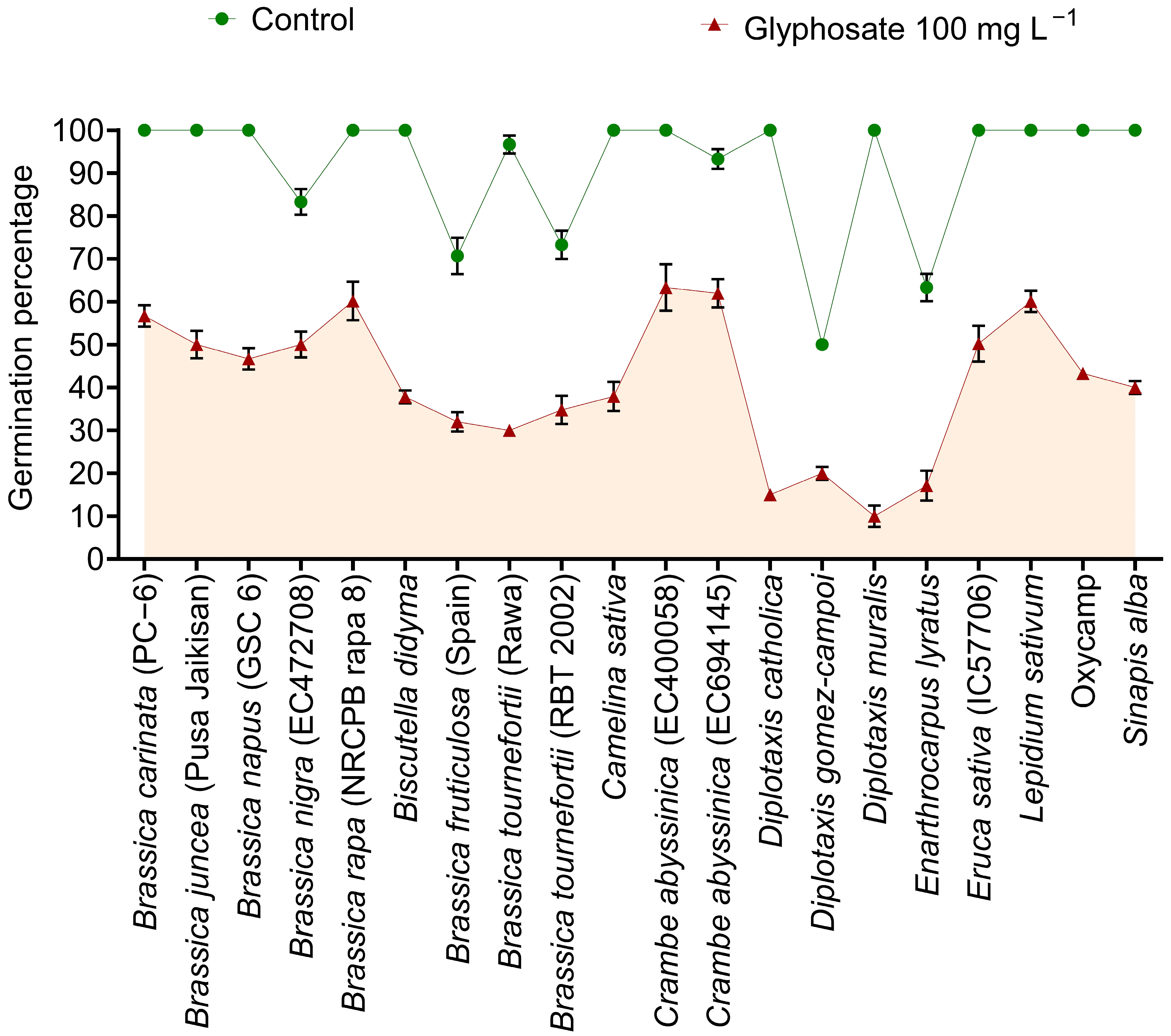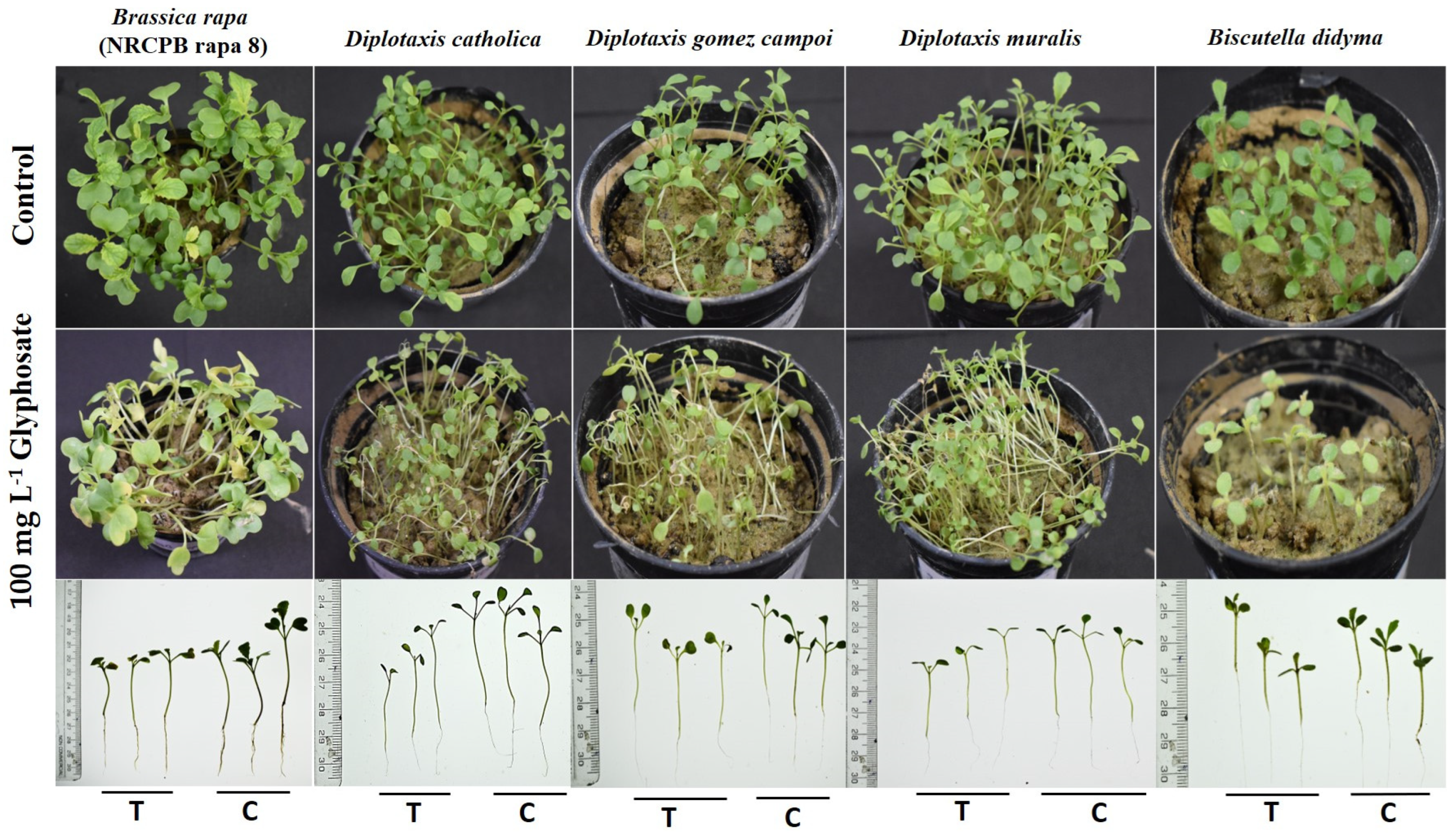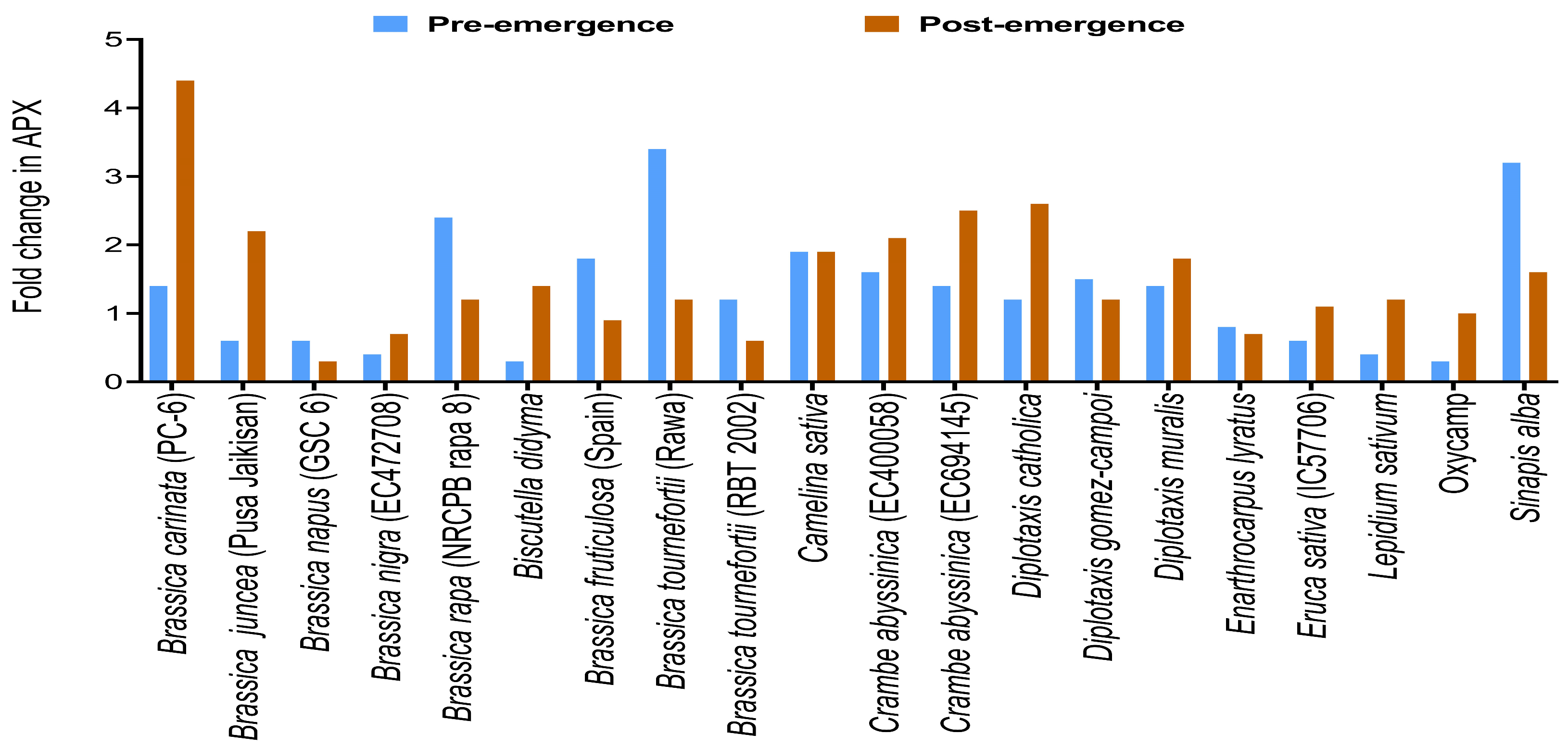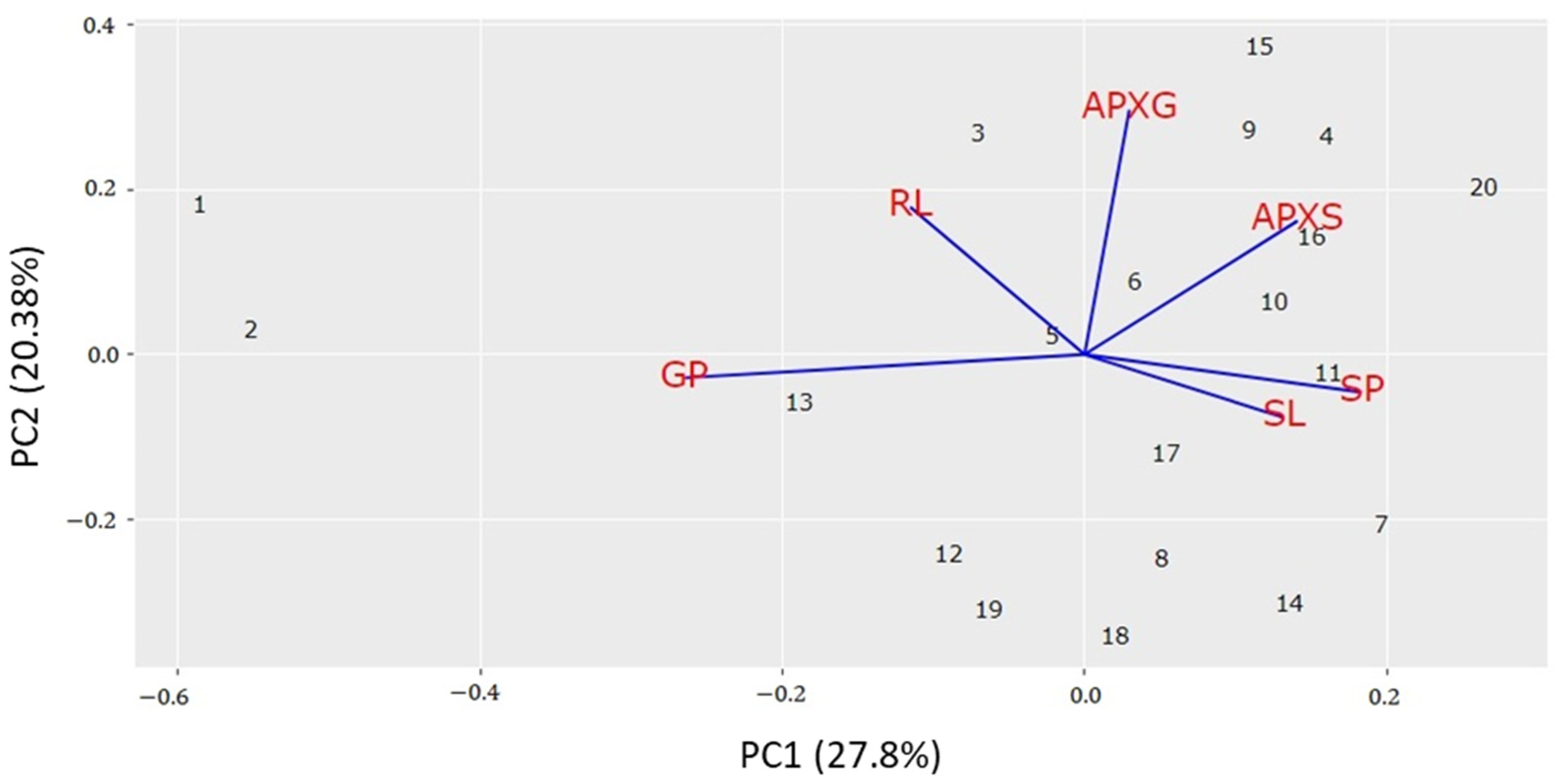Morpho-Biochemical Responses of Brassica Coenospecies to Glyphosate Exposure at Pre- and Post-Emergence Stages
Abstract
1. Introduction
2. Materials and Methods
2.1. Experimental Material
2.2. Germination Test (Pre-Emergence)
2.3. Spray Test (Post-Emergence)
2.4. Biochemical Assay: Ascorbate Peroxidase (APX)
2.5. Protein Estimation
2.6. Tolerance Index and Membership Function Value (MFV)
2.7. Statistical Analysis
3. Results
3.1. Pre-Emergence and Post-Emergence Effects of Glyphosate
3.2. Tolerance Index and Membership Function Value
3.3. Multivariate Cluster Analysis
3.4. Biochemical Assessment of Ascorbate Peroxidase
3.5. Principal Component Analysis (PCA)
4. Discussion
5. Conclusions
Supplementary Materials
Author Contributions
Funding
Data Availability Statement
Acknowledgments
Conflicts of Interest
References
- Baylis, A.D. Why Glyphosate Is a Global Herbicide: Strengths, Weaknesses and Prospects. Pest Manag. Sci. 2000, 56, 299–308. [Google Scholar] [CrossRef]
- Shaner, D.L. Role of Translocation as A Mechanism of Resistance to Glyphosate. Weed Sci. 2009, 57, 118–123. [Google Scholar] [CrossRef]
- Dekker, J.; Duke, S. Herbicide-Resistant Field Crops. Adv. Agron. 1995, 54, 69–116. [Google Scholar]
- Jensen, R.A. The Shikimate/Arogenate Pathway: Link between Carbohydrate Metabolism and Secondary Metabolism. Physiol. Plant. 1986, 66, 164–168. [Google Scholar] [CrossRef]
- Hill, J.; Lethenborg, P.; Li, P.W.; Rahman, M.H.; Sørensen, H.; Sørensen, J.C. Inheritance of Progoitrin and Total Aliphatic Glucosinolates in Oilseed Rape (Brassica napus L.). Euphytica 2003, 134, 179–187. [Google Scholar] [CrossRef]
- Rasmussen, K.W.; Bjerg, B.; Olsen, O.; Sorensen, H. New Principles Of Ion-Exchange Techniques Suitable To Sample Preparation And Group Separation Of Natural Products Prior To Liquid Chromatography. J. Liq. Chromatogr. 1984, 7, 691–707. [Google Scholar] [CrossRef]
- Rodman, J.E. A Taxonomic Analysis of Glucosinolate-Producing Plants, Part 1: Phenetics. Syst. Bot. 1991, 16, 598. [Google Scholar] [CrossRef]
- Duke, S.O. The History and Current Status of Glyphosate. Pest Manag. Sci. 2018, 74, 1027–1034. [Google Scholar] [CrossRef]
- Nandula, K. Glyphosate Resistance in Crops and Weeds: History, Development, and Management; Wiley: Hoboken, NJ, USA, 2010; ISBN 9780470410318. [Google Scholar]
- Gaines, T.A.; Patterson, E.L.; Neve, P. Molecular Mechanisms of Adaptive Evolution Revealed by Global Selection for Glyphosate Resistance. New Phytol. 2019, 223, 1770–1775. [Google Scholar] [CrossRef]
- Délye, C. Unravelling the Genetic Bases of Non-Target-Site-Based Resistance (NTSR) to Herbicides: A Major Challenge for Weed Science in the Forthcoming Decade. Pest Manag. Sci. 2013, 69, 176–187. [Google Scholar] [CrossRef]
- Alarcón-Reverte, R.; García, A.; Watson, S.B.; Abdallah, I.; Sabaté, S.; Hernández, M.J.; Dayan, F.E.; Fischer, A.J. Concerted Action of Target-Site Mutations and High EPSPS Activity in Glyphosate-Resistant Junglerice (Echinochloa colona) from California. Pest Manag. Sci. 2015, 71, 996–1007. [Google Scholar] [CrossRef]
- Okumu, M.N.; Robbertse, P.J.; Vorster, B.J.; Reinhardt, C.F. The Molecular, Morphological and Genetic Characterization of Glyphosate Resistance in Conyza Bonariensis from South Africa. Plants 2022, 11, 2830. [Google Scholar] [CrossRef]
- Caseley, J.; Copping, L. Twenty-Five Years of Increasing Glyphosate Use: The Opportunities Ahead. Pest Manag. Sci. 2000, 56, 297. [Google Scholar] [CrossRef]
- Bradshaw, L.D.; Padgette, S.R.; Kimball, S.L.; Wells, B.H. Perspectives on Glyphosate Resistance. Weed Technol. 1997, 11, 189–198. [Google Scholar] [CrossRef]
- Nandula, V.K.; Reddy, K.N.; Duke, S.O.; Poston, D.H. Glyphosate-Resistant Weeds: Current Status and Future Outlook. Outlooks Pest Manag. 2005, 16, 183–187. [Google Scholar] [CrossRef]
- Punia, S. Biology and Control Measures of Orobanche. Indian Soc. Weed Sci. 2014, 46, 36–51. [Google Scholar]
- Punia, S. Control of Broomrape in Indian Mustard. Indian Soc. Weed Sci. 2015, 47, 170–173. [Google Scholar]
- Agarwal, P.; Mukhopadhyay, A.; Gupta, V.; Pradhan, A.K.; Pental, D. Glyphosate-Resistant Brassica juncea (Oilseed Mustard) Transgenics for Possible Control of Root Parasite Orobanche Aegyptiaca and Conservation Agriculture. J. Plant Biochem. Biotechnol. 2022, 31, 648–656. [Google Scholar] [CrossRef]
- Hasan, M.; Mokhtar, A.S.; Mahmud, K.; Berahim, Z.; Rosli, A.M.; Hamdan, H.; Motmainna, M.; Ahmad-Hamdani, M.S. Physiological and Biochemical Responses of Selected Weed and Crop Species to the Plant-Based Bioherbicide WeedLock. Sci. Rep. 2022, 12, 19602. [Google Scholar] [CrossRef]
- Juan, V.F.; Núñez Fré, F.R.; Saint-André, H.M.; Fernández, R.R. Responses of 2,4-D Resistant Brassica rapa L. Biotype to Various 2,4-D Formulations and Other Auxinic Herbicides. Crop Prot. 2021, 145, 2–7. [Google Scholar] [CrossRef]
- Kashyap, A.; Kumari, S.; Garg, P.; Kushwaha, R.; Tripathi, S.; Sharma, J.; Gupta, N.C.; Kumar, R.R.; Yadav, R.; Vishwakarma, H.; et al. Indexing Resilience to Heat and Drought Stress in the Wild Relatives of Rapeseed-Mustard. Life 2023, 13, 738. [Google Scholar] [CrossRef] [PubMed]
- Huangfu, C.H.; Song, X.L.; Qiang, S.; Zhang, H.J. Response of Wild Brassica juncea Populations to Glyphosate. Pest Manag. Sci. 2007, 63, 1133–1140. [Google Scholar] [CrossRef]
- Chen, G.X.; Asada, K. Ascorbate Peroxidase in Tea Leaves: Occurrence of Two Isozymes and the Differences in Their Enzymatic and Molecular Properties. Plant Cell Physiol. 1989, 30, 987–998. [Google Scholar] [CrossRef]
- Chen, X.; Min, D.; Yasir, T.A.; Hu, Y.-G. Evaluation of 14 Morphological, Yield-Related and Physiological Traits as Indicators of Drought Tolerance in Chinese Winter Bread Wheat Revealed by Analysis of the Membership Function Value of Drought Tolerance (MFVD). Field Crop. Res. 2012, 137, 195–201. [Google Scholar] [CrossRef]
- Rai, A.N.; Saini, N.; Yadav, R.; Suprasanna, P. A Potential Seedling-Stage Evaluation Method for Heat Tolerance in Indian Mustard (Brassica juncea L. Czern and Coss). 3 Biotech 2020, 10, 114. [Google Scholar] [CrossRef]
- Achary, V.M.M.; Sheri, V.; Manna, M.; Panditi, V.; Borphukan, B.; Ram, B.; Agarwal, A.; Fartyal, D.; Teotia, D.; Masakapalli, S.K.; et al. Overexpression of Improved EPSPS Gene Results in Field Level Glyphosate Tolerance and Higher Grain Yield in Rice. Plant Biotechnol. J. 2020, 18, 2504–2519. [Google Scholar] [CrossRef]
- Helander, M.; Saloniemi, I.; Saikkonen, K. Glyphosate in Northern Ecosystems. Trends Plant Sci. 2012, 17, 569–574. [Google Scholar] [CrossRef]
- Nguyen, T.C.T.; Abrams, S.R.; Friedt, W.; Snowdon, R.J. Quantitative Trait Locus Analysis of Seed Germination, Seedling Vigour and Seedling-Regulated Hormones in Brassica napus. Plant Breed. 2018, 137, 388–401. [Google Scholar] [CrossRef]
- Donohue, K.; Rubio De Casas, R.; Burghardt, L.; Kovach, K.; Willis, C.G. Germination, Postgermination Adaptation, and Species Ecological Ranges. Annu. Rev. Ecol. Evol. Syst. 2010, 41, 293–319. [Google Scholar] [CrossRef]
- Jha, S.; Singh, J.; Chouhan, C.; Singh, O.; Srivastava, R.K. Evaluation of Multiple Salinity Tolerance Indices for Screening and Comparative Biochemical and Molecular Analysis of Pearl Millet [Pennisetum glaucum (L.) R. Br.] Genotypes. J. Plant Growth Regul. 2022, 41, 1820–1834. [Google Scholar] [CrossRef]
- Zadeh, L.A. Fuzzy Sets. Inf. Control 1965, 8, 338–353. [Google Scholar] [CrossRef]
- Hassan, E.A. The Influence of Glyphosate on Germination Behaviour of Wheat (Triticum aestivum L.). J. Agron. Crop Sci. 1988, 161, 73–78. [Google Scholar] [CrossRef]
- Young, F.L.; Gealy, D.R.; Morrow, L.A. Effect of Herbicides on Germination and Growth of Four Grass Weeds. Weed Sci. 1984, 32, 489–493. [Google Scholar] [CrossRef]
- Baur, J.R.; Miller, F.R.; Bovey, R.W. Effects of Preharvest Desiccation with Glyphosate on Grain Sorghum Seed 1. Agron. J. 1977, 69, 1015–1018. [Google Scholar] [CrossRef]
- Bovey, R.W.; Miller, F.R.; Baur, J.R. Preharvest Desiccation of Grain Sorghum with Glyphosate. Agron. J. 1975, 67, 618–621. [Google Scholar] [CrossRef]
- Yenish, J.P.; Young, F.L. Effect of Preharvest Glyphosate Application on Seed and Seedling Quality of Spring Wheat (Triticum aestivum). Weed Technol. 2000, 14, 212–217. [Google Scholar] [CrossRef]
- Baig, M.N.; Darwent, A.L.; Harker, K.N.; O’Donovan, J.T. Preharvest Applications of Glyphosate Affect Emergence and Seedling Growth of Field Pea (Pisum sativum). Weed Technol. 2003, 17, 655–665. [Google Scholar] [CrossRef]
- Jeffery, L.S.; English, J.R.; Connell, J. The effects of fall application of glyphosate on corn (Zea mays), soybeans (Glycine max), and johnsongrass (Sorghum halepense). Weed Sci. 1981, 29, 190–195. [Google Scholar] [CrossRef]
- Mondal, S.; Kumar, M.; Haque, S.; Kundu, D. Phytotoxicity of Glyphosate in the Germination of Pisum Sativum and Its Effect on Germinated Seedlings. Environ. Health Toxicol. 2017, 32, e2017011. [Google Scholar] [CrossRef]
- de Oliveira Neto, S.S.; Bossolani, J.W.; de Freitas, S.E.; Gazola, B.; Gonçalves, A.S.F.; Zoz, T.; Calonego, J.C. Impact of Glyphosate on Morphophysiological Traits of RR Corn Plants under Drought Stress. Acta Physiol. Plant. 2023, 45, 28. [Google Scholar] [CrossRef]
- Kohata, K.; Yamauchi, Y.; Ujihara, T.; Horie, H. Growth Inhibitory Activity of Tea-Seed Saponins and Glyphosate to Weed Seedlings. Japan Agric. Res. Q. 2004, 38, 267–270. [Google Scholar] [CrossRef]
- Gomes, M.P.; da Silva Cruz, F.V.; Bicalho, E.M.; Borges, F.V.; Fonseca, M.B.; Juneau, P.; Garcia, Q.S. Effects of Glyphosate Acid and the Glyphosate-Commercial Formulation (Roundup) on Dimorphandra Wilsonii Seed Germination: Interference of Seed Respiratory Metabolism. Environ. Pollut. 2017, 220, 452–459. [Google Scholar] [CrossRef] [PubMed]
- El-Maarouf-Bouteau, H.; Bailly, C. Oxidative Signaling in Seed Germination and Dormancy. Plant Signal. Behav. 2008, 3, 175–182. [Google Scholar] [CrossRef] [PubMed]
- Gomes, M.P.; Kitamura, R.S.A.; Marques, R.Z.; Barbato, M.L.; Zámocký, M. The Role of H2O2-Scavenging Enzymes (Ascorbate Peroxidase and Catalase) in the Tolerance of Lemna Minor to Antibiotics: Implications for Phytoremediation. Antioxidants 2022, 11, 151. [Google Scholar] [CrossRef]
- Černý, M.; Habánová, H.; Berka, M.; Luklová, M.; Brzobohatý, B. Hydrogen Peroxide: Its Role in Plant Biology and Crosstalk with Signalling Networks. Int. J. Mol. Sci. 2018, 19, 2812. [Google Scholar] [CrossRef]





| S. No. | Genotypes | % Decrease | SP | ||
|---|---|---|---|---|---|
| SL | RL | GP | |||
| 1 | Brassica carinata (PC-6) | 47.5 [7] | 92.0 [17] | 43.3 [5] | 56.6 [2] |
| 2 | Brassica juncea (Pusa Jaikisan) | 60.1 [11] | 90.0 [14] | 50.0 [7] | 50.0 [8] |
| 3 | Brassica napus (GSC 6) | 63.3 [14] | 93.7 [20] | 53.3 [9] | 46.6 [10] |
| 4 | Brassica nigra (EC472708) | 22.1 [1] | 89.1 [10] | 40.0 [4] | 40.0 [12] |
| 5 | Brassica rapa (NRCPB rapa 8) | 67.8 [16] | 89.8 [12] | 39.7 [3] | 63.2 [1] |
| 6 | Biscutella didyma | 70.4 [17] | 77.5 [6] | 62.1 [16] | 35.8 [15] |
| 7 | Brassica fruticulosa (Spain) | 76.0 [19] | 76.0 [4] | 54.7 [10] | 21.4 [18] |
| 8 | Brassica tournefortii (Rawa) | 50.9 [8] | 80.4 [8] | 68.9 [17] | 40.0 [11] |
| 9 | Brassica tournefortii (RBT 2002) | 61.5 [13] | 75.6 [3] | 52.5 [8] | 20.0 [19] |
| 10 | Camelina sativa | 75.0 [18] | 78.0 [7] | 62.0 [15] | 35.9 [14] |
| 11 | Crambe abyssinica (EC400058) | 65.8 [15] | 91.3 [15] | 36.6 [2] | 51.0 [6] |
| 12 | Crambe abyssinica (EC694145) | 35.8 [3] | 93.2 [19] | 33.5 [1] | 52.0 [5] |
| 13 | Diplotaxis catholica | 53.2 [10] | 65.7 [1] | 85.0 [19] | 20.0 [20] |
| 14 | Diplotaxis muralis | 26.9 [2] | 71.0 [2] | 90.0 [20] | 30.0 [16] |
| 15 | Diplotaxis gomez-campoi | 42.6 [6] | 76.9 [5] | 60.0 [12] | 28.0 [17] |
| 16 | Enarthrocarpus lyratus | 36.1 [4] | 85.1 [9] | 72.9 [18] | 37.1 [13] |
| 17 | Eruca sativa (IC57706) | 86.3 [20] | 93.1 [18] | 49.7 [6] | 53.2 [4] |
| 18 | Lepidium sativum | 39.8 [5] | 89.8 [13] | 43.3 [14] | 46.6 [9] |
| 19 | Oxycamp | 52.2 [9] | 91.6 [16] | 56.6 [11] | 53.3 [3] |
| 20 | Sinapis alba | 60.5 [12] | 89.8 [11] | 60.0 [13] | 50.0 [7] |
| S. No. | Genotypes | Control | Treatment | ||
|---|---|---|---|---|---|
| Root Length | Shoot Length | Root Length | Shoot Length | ||
| 1 | Brassica carinata (PC-6) | 6.2 ± 0.21 F | 4.0 ± 0.25 I | 0.5 ± 0.10 B | 2.1 ± 0.75 G |
| 2 | Brassica juncea (Pusa Jaikisan) | 9.0 ± 2.9 F | 4.6 ± 0.53 I | 0.9 ± 0.44 B | 1.8 ± 1.12 FG |
| 3 | Brassica napus (GSC 6) | 8.5 ± 2.48 F | 5.3 ± 0.9 I | 0.5 ± 0.06 B | 1.9 ± 0.21 G |
| 4 | Brassica nigra (EC472708) | 4 ± 1.82 F | 3.7 ± 1.00 I | 0.4 ± 0.15 B | 2.9 ± 0.23 G |
| 5 | Brassica rapa (NRCPB rapa 8) | 3.9 ± 1.48 F | 3.7 ± 0.06 HI | 0.4 ± 0.10 B | 1.2 ± 0.36 FG |
| 6 | Biscutella didyma | 1.9 ± 0.21 EF | 2.3 ± 0.32 FGH | 0.4 ± 0.15 B | 0.7 ± 0.26 DEFG |
| 7 | Brassica fruticulosa (Spain) | 1.6 ± 0.49 A | 3.0 ± 0.31 A | 0.4 ± 0.10 A | 0.7 ± 0.06 A |
| 8 | Brassica tournefortii (Rawa) | 1.3 ± 0.21 F | 3.6 ± 0.87 GHI | 0.2 ± 0.15 B | 1.8 ± 0.26 EFG |
| 9 | Brassica tournefortii (RBT 2002) | 1.3 ± 0.06 A | 3.4 ± 0.25 A | 0.3 ± 0.06 B | 1.3 ± 0.47 B |
| 10 | Camelina sativa | 1.6 ± 0.15 B | 2.8 ± 0.26 AB | 0.3 ± 0.06 B | 0.7 ± 0.1 BC |
| 11 | Crambe abyssinica (EC400058) | 5.8 ± 1.51 CDE | 5.6 ± 0.25 EFG | 0.5 ± 0.17 B | 1.9 ± 0.25 CDE |
| 12 | Crambe abyssinica (EC694145) | 4.4 ± 0.64 CDE | 5.8 ± 0.98 EFG | 0.3 ± 00 B | 3.7 ± 0.47 DEF |
| 13 | Diplotaxis catholica | 1.1 ± 0.15 B | 2.0 ± 0.35 ABC | 0.4 ± 0.10 B | 0.9 ± 0.06 BC |
| 14 | Diplotaxis muralis | 1.2 ± 0.15 BC | 2.1 ± 0.10 BCDE | 0.3 ± 0.15 B | 1.5 ± 0.21 CDE |
| 15 | Diplotaxis gomez-campoi | 1.3 ± 0.1 CB | 2.5 ± 0.30 ABCD | 0.3 ± 0.10 B | 1.4 ± 0.12 CD |
| 16 | Enarthrocarpus lyratus | 2.4 ± 1.01 BCD | 2.4 ± 0.66 CDE | 0.3 ± 0.06 B | 1.5 ± 0.32 CDE |
| 17 | Eruca sativa (IC57706) | 6.3 ± 1.0 DEF | 5.87 ± 0.32 EFG | 0.4 ± 0.06 B | 0.8 ± 0.1 DEF |
| 18 | Lepidium sativum | 4.6 ± 1.04 BCD | 4.1 ± 0.20 DEF | 0.4 ± 0.31 B | 2.4 ± 0.4 CDE |
| 19 | Oxycamp | 6 ± 1.80 F | 5.1 ± 1.04 FGHI | 0.5 ± 0.10 B | 2.4 ± 0.42 EFG |
| 20 | Sinapis alba | 3.93 ± 0.21 CDE | 4.73 ± 0.75 DEF | 0.4 ± 0.17 B | 1.87 ± 0.4 CDE |
Disclaimer/Publisher’s Note: The statements, opinions and data contained in all publications are solely those of the individual author(s) and contributor(s) and not of MDPI and/or the editor(s). MDPI and/or the editor(s) disclaim responsibility for any injury to people or property resulting from any ideas, methods, instructions or products referred to in the content. |
© 2023 by the authors. Licensee MDPI, Basel, Switzerland. This article is an open access article distributed under the terms and conditions of the Creative Commons Attribution (CC BY) license (https://creativecommons.org/licenses/by/4.0/).
Share and Cite
Kashyap, A.; Kumari, S.; Garg, P.; Kushwaha, R.; Tripathi, S.; Sharma, J.; Gupta, N.C.; Kumar, R.R.; Vishwakarma, H.; Bhattacharya, R.; et al. Morpho-Biochemical Responses of Brassica Coenospecies to Glyphosate Exposure at Pre- and Post-Emergence Stages. Agronomy 2023, 13, 1831. https://doi.org/10.3390/agronomy13071831
Kashyap A, Kumari S, Garg P, Kushwaha R, Tripathi S, Sharma J, Gupta NC, Kumar RR, Vishwakarma H, Bhattacharya R, et al. Morpho-Biochemical Responses of Brassica Coenospecies to Glyphosate Exposure at Pre- and Post-Emergence Stages. Agronomy. 2023; 13(7):1831. https://doi.org/10.3390/agronomy13071831
Chicago/Turabian StyleKashyap, Anamika, Sujata Kumari, Pooja Garg, Ranjeet Kushwaha, Shikha Tripathi, Jyoti Sharma, Navin C. Gupta, Rajeev Ranjan Kumar, Harinder Vishwakarma, Ramcharan Bhattacharya, and et al. 2023. "Morpho-Biochemical Responses of Brassica Coenospecies to Glyphosate Exposure at Pre- and Post-Emergence Stages" Agronomy 13, no. 7: 1831. https://doi.org/10.3390/agronomy13071831
APA StyleKashyap, A., Kumari, S., Garg, P., Kushwaha, R., Tripathi, S., Sharma, J., Gupta, N. C., Kumar, R. R., Vishwakarma, H., Bhattacharya, R., Yadav, R., Rana, J. C., & Rao, M. (2023). Morpho-Biochemical Responses of Brassica Coenospecies to Glyphosate Exposure at Pre- and Post-Emergence Stages. Agronomy, 13(7), 1831. https://doi.org/10.3390/agronomy13071831










